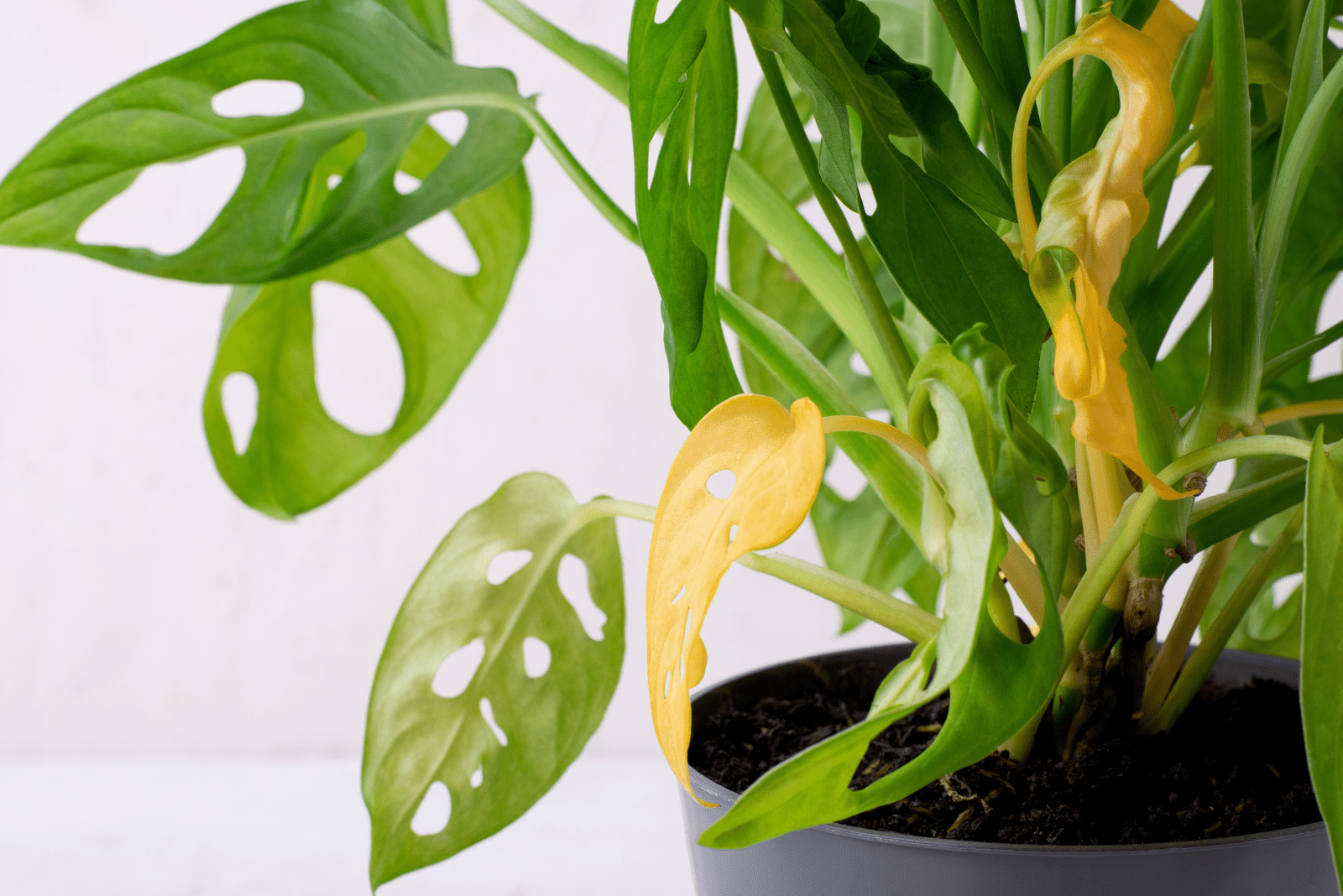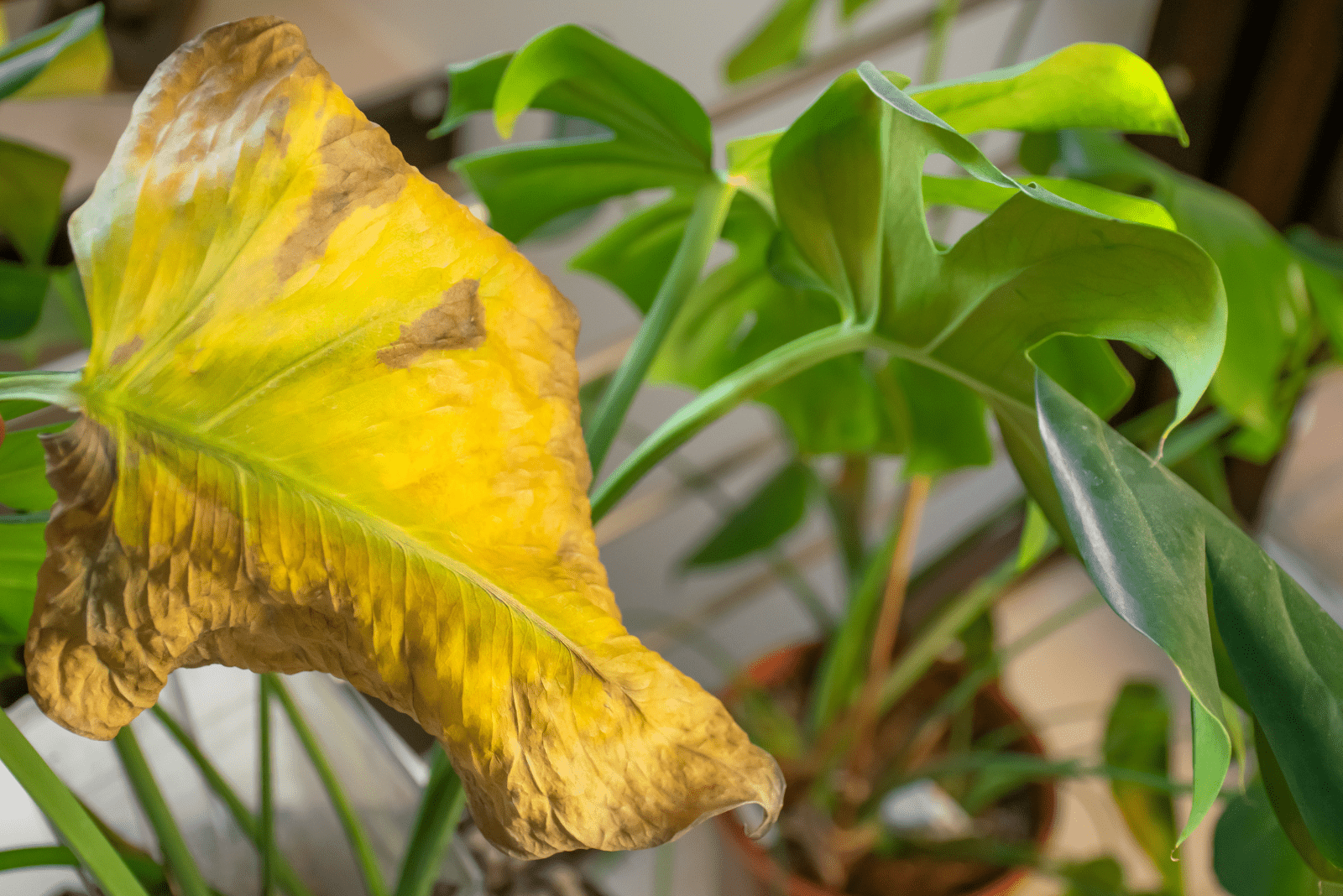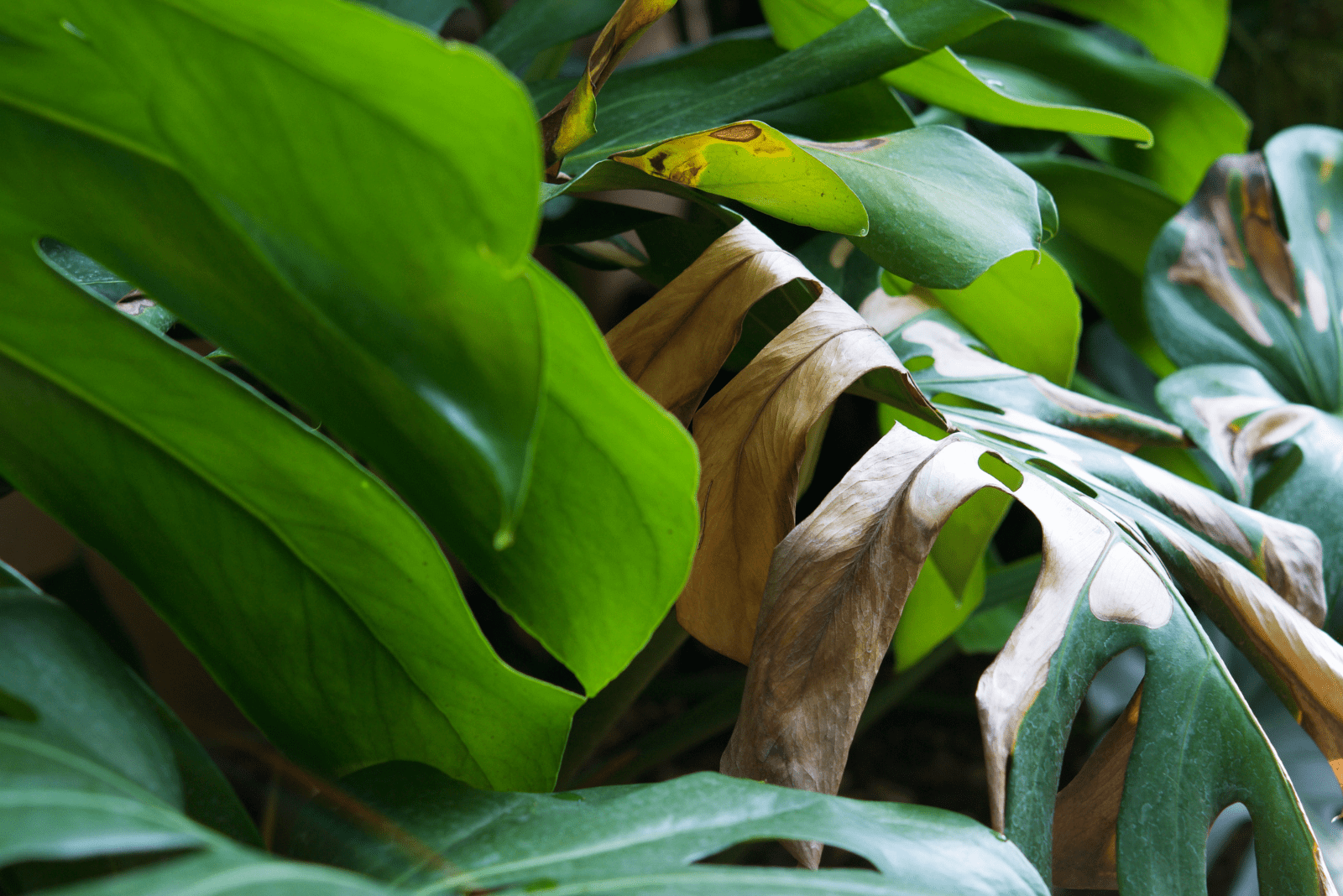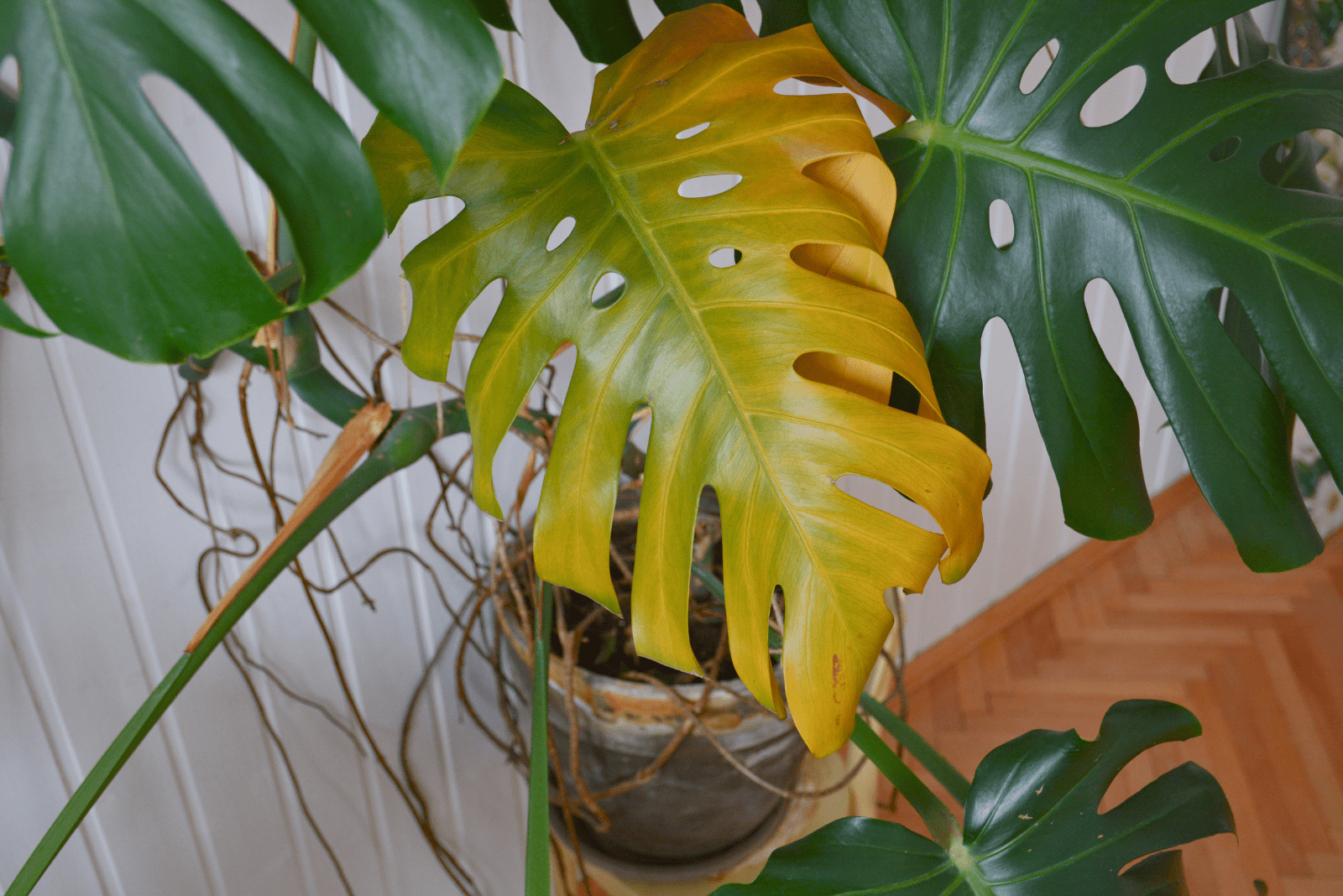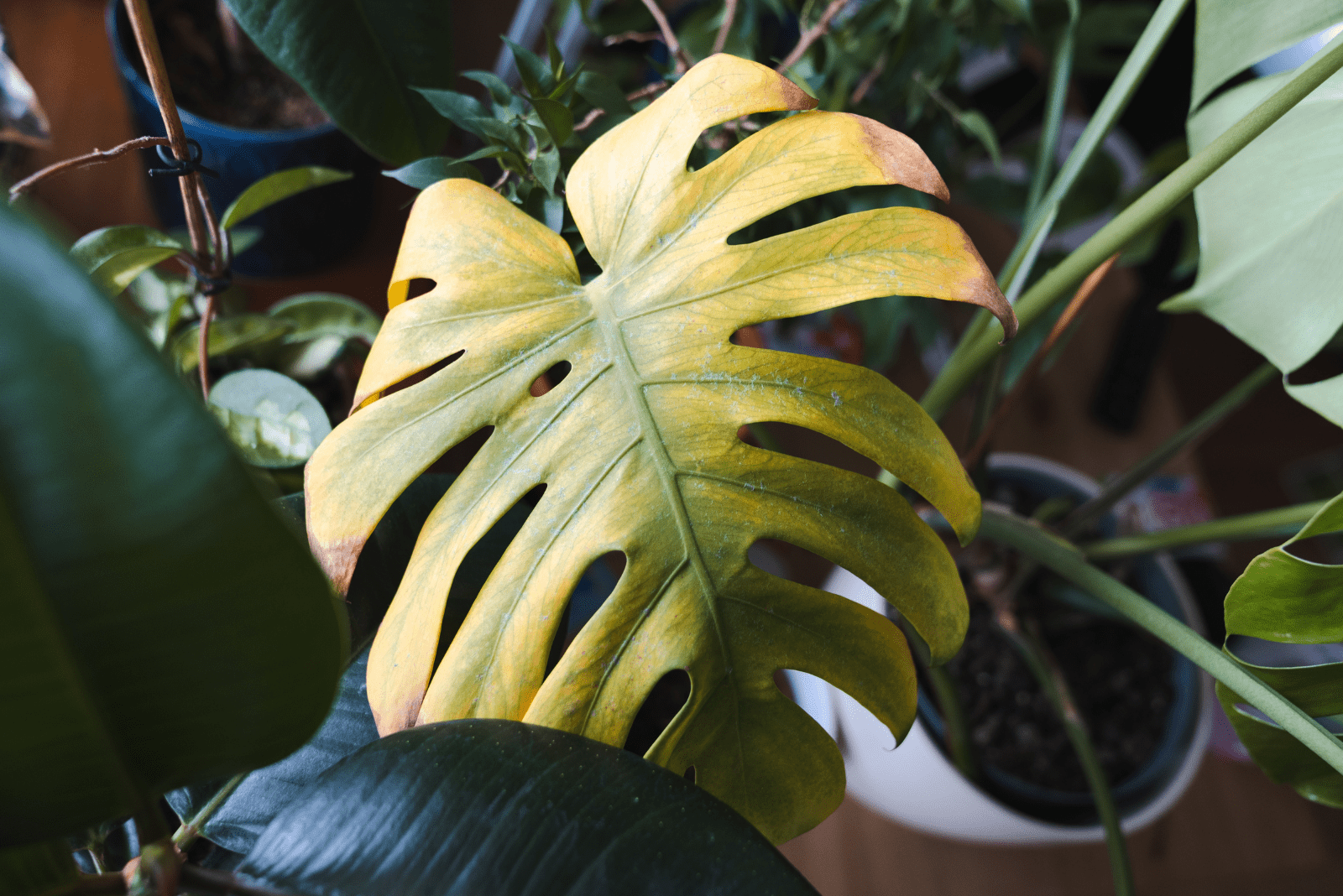Monstera plants are popular because of their majestic, green leaves… so what does it mean when they start turning yellow?
Though you might think that your plant is wilting and dying, these issues can easily be fixed, and your plant will look as good as new!
Yellow leaves are common issues with a lot of houseplants, and it is usually associated with improper plant care. All you have to do is figure out the issue and try to fix it!
At the beginning of my gardening journey, I asked, why is my Monstera turning yellow?
I have studied a lot and tried all sorts of methods to fix my Monstera leaves, and I succeeded, so I am here to share everything you need to know!
Why Is My Monstera Turning Yellow? Problems & Solutions
The majority of reasons your plant has yellow leaves aren’t that serious, and most of them can be easily fixed. However, if overwatering is the issue, for example, you must act quickly or you might end up with Monstera root rot.
Root rot is a serious fungal disease that can completely ruin your plant, so you have to do everything you can to try and fix it!
Other issues are associated with plant care, such as fertilization, watering, light conditions, humidity, and temperature.
You have to determine the actual issue and find a way to solve it.
Keep reading to learn more!
1. Inadequate Watering
Monsteras are tropical plants that originate from the deep forests of Central America. Therefore, they are used to growing in moist soil and high humidity. To keep your plants happy and healthy, you should try and recreate their natural habitat.
If we take into consideration that they need moist soil, it means you will have to water them more frequently. Some gardeners take this way too seriously and give them more than enough water.
This leads to an overwatered Monstera plant.
On the contrary, if you forget a few watering sessions, the soil might get too compact and you will end up with an underwatered Monstera plant.
Overwatering
Overwatering is probably the most common reason for Monstera leaves turning yellow. The plant leaves might also have a chocolate brown color because plants also need oxygen.
Excess water in the soil disrupts normal airflow in the soil, which prevents the air from reaching the plant’s roots. This lowers the amount of oxygen that the plant needs, and the leaves respond to this by developing brown spots on their surfaces.
Other signs are mold on the soil and blisters on the leaves.
However, you can easily find the answer by touching the soil to feel if it is wet, and also by remembering when you last watered your Monstera plant.
If the soil starts to smell funny, then you are probably dealing with root rot. Yellowing of the lower leaves is also a sign of this fungal infection. Root rot is a serious disease that can lead to plant death, so it is extremely important that you act quickly if you want to save your plant.
How To Fix
Changing your watering routine is the first item on the agenda. You can’t keep watering your plant frequently, especially if it’s growing in conditions with high humidity and temperature. Therefore, you should put your plant’s needs first and check the soil before watering.
If the top few inches of the soil have already dried, then you should water your plant. You can use either a wooden stick or a moisture meter to check the soil, or you can use your fingers if you don’t mind getting a little dirty!
If the soil still feels wet, then you should postpone watering for a couple of days.
Instead of soaking the entire plant, pour water on the soil until it’s about two inches below the surface. You can also use bottom watering.
The best type of water that you can use for your Monstera plant is rainwater or filtered water, though you can also leave tap water overnight so that all the harmful chemicals can evaporate.
If you notice that the soil starts to smell and you suspect that your plant might have root rot, then the best option is repotting. When repotting a plant, make sure to buy a new pot and soil, and also trim off any brown and mushy roots you find.
If your plant has reached the point that it can no longer be saved, you can always try propagation.
The safest way to prevent overwatering is to provide proper drainage. This includes putting your plant in well-draining potting soil, and making sure that there are drainage holes in the bottom of the pot. Terracotta pots might be the best type of pots for Monstera plants because they are made out of porous material that allows water evaporation.
Underwatering
Underwatering is the opposite of overwatering. It means that you haven’t been giving your plant enough water, and it’s now wilting and dying.
In addition to Monstera leaves turning yellow, other signs of an underwatered Monstera include curling leaves, brown leaves, bone dry soil and soil that is too compact, almost no fenestration, and stunted growth.
You can simply check the soil moisture if you cannot recall if you have watered your Monstera.
If the soil gets too compact, it might not be able to absorb water or allow your plant’s roots to absorb any, so you should repot the plant in this scenario.
Luckily, underwatering is not as serious as overwatering because it isn’t accompanied by a deadly infection, but if you still neglect your plant for a long period of time then it will probably deteriorate.
How To Fix
Monsteras need a good drink when they get thirsty! Put the plant into the sink, then let the water take care of the rest. A watering can is also an option.
Don’t use all the water you prepared at once, but gradually pour it into the pot, which should have drainage holes in the bottom. Avoid letting the Monstera soil become soggy. Make sure the water doesn’t touch the leaves as you pour it onto the soil.
Keep going until you notice water dripping from the drainage holes.
When you are done soaking, immediately empty the drainage tray.
It’s time for your Monstera to drain. A hydrated plant should never be left in the sun while draining because doing so will result in permanent damage.
If the soil got too compact, you should repot the plant. Make sure that you use a potting mix that is well draining — you can either buy it in a store or make your own. The best potting mix recipe consists of 1/3 vermiculite, 1/3 peat moss, and 1/3 perlite.
2. Low Humidity
As we mentioned, these are tropical plants that originate from deep rainforests. They are used to growing in humid environments, and there can be issues if they are grown in low humidity levels.
Monstera plants thrive in humidity levels of around 65%, and most houses have around 30% to 50% humidity levels. This is too dry for your Monstera indoor plant, which is why your plant might start acting differently.
The Monstera genus is well known for its ability to produce wax and secretions on its leaves, which act as a defense against pathogens and pests.
If your Monstera is in low humidity conditions, the wax will solidify. This deformation will be brought on by the dry, brisk air in this situation. The fact that this protects Monsteras is a plus, but the negative impact it has on the plant’s overall health and beauty is a drawback.
This problem primarily affects Monstera leaves during the colder months when people use heating sources to warm their homes. For instance, your Monstera deliciosa might have enough nourishment, but as the humidity drops, its leaves won’t open.
In this scenario, the leaves will become yellow and brown, especially the edges, which will be crisp and dry.
Your Monstera will appear weak and wilted, and a lack of water and intense light can make things even worse.
How To Fix
Luckily, these issues are easily fixed! All you have to do is find a way to increase humidity levels. There are a few ways that you can do this, for instance, investing in a humidifier. These devices are extremely useful because you can set required humidity levels and the device automatically turns off once those levels are reached. They are not even that expensive – you can find them on Amazon for 20 bucks!
Another low-cost method to increase humidity is creating a pebble tray. Put some pebbles in a tray and cover them with water. Put your plant on top of the tray, and as the water evaporates, your plant will get enough moisture.
Misting is also an effective method — all you need is a spray bottle and some water. Spray water on the leaves every other day, and make sure that you do it in the morning so that the water can evaporate during the day. The leaves will become sensitive to fungi that cause them to rot if water from the leaves doesn’t evaporate quickly enough and remains on them for too long.
Grouping the plants is also an option if you have many plants. You can place Philodendrons or Snake Plants next to your Monstera to increase humidity for both of them!
This method works based on plant transpiration. As the water evaporates from the plants, it will create a humid microclimate. However, this requires lots of plants and it takes a lot of space!
Lastly, you can put the plant in a room that has high humidity levels, such as the kitchen or bathroom. You have to make sure that there is enough light for these plants because they are not able to grow normally in low light conditions.
3. Improper Light Conditions
There are several houseplants that can grow in low light conditions. Unfortunately, this does not include our Swiss cheese plant. Low light can affect your plant’s health, but direct sunlight is not a good option either.
Successful photosynthesis results in new leaves and new growth, and plants require enough energy to photosynthesize. They also make use of this energy to promote leaf unfurling and stop tissue damage.
If your Monstera doesn’t receive enough light, its new leaves will take a long time to open or won’t unfold at all. This is because the proper amount of light is necessary to ensure that there is adequate energy for this process.
If your plant doesn’t get enough light, unfolding problems won’t be your biggest concern.
Your Monstera will appear lanky, the lack of chlorophyll will cause the leaves to turn yellow, and the soil will dry out slowly. After that, you’ll think that your Monstera needs water so you will keep watering the plant, which can lead to overwatering.
On the other hand, if you keep your Monstera plant in full sun, those precious leaves might get burned! Dry and brown spots with yellow discolorations around them are damaged portions of the leaves, and you can’t do anything to save those old leaves.
However, you can trim them off to encourage new growth!
How To Fix
We frequently place new plants where they would look best in terms of décor, however, keep in mind that plants like Monsteras don’t do well in too little light.
Consider windows. It may make perfect sense to put plants on windows so they get enough light, yet doing so is also ineffective. Low light conditions are not the only thing that should be avoided.
If you put them in windows that get exposed to direct sunlight throughout the day, your plant will end up getting sunburned.
You’ll need to find a location with indirect light. I suggest a south or east-facing window so your Monstera doesn’t suffer from direct sunlight or low light.
If your plant still needs more light, you can purchase grow lights on Amazon. If it already has enough light, you can get sheer curtains.
4. Wrong Temperature
There’s no winter season in tropical regions, so keeping your plant in low temperatures can potentially harm them. On the contrary, extremely warm temperatures and direct sunlight aren’t great options either.
If the temperature drops below 50 degrees Fahrenheit, your plant will stop growing and it will suffer from cold damage. This can affect both newer and older leaves, though new leaves are fragile and more prone to temperature stress.
The leaves will start turning yellow, brown, and crispy.
How To Fix
As we mentioned, these plants prefer growing in bright indirect sunlight. If you keep them near a window that gets direct afternoon sun, it will definitely harm your plant.
Monstera plants thrive in temperatures from 65 to 85 Fahrenheit degrees. Any sudden temperature changes might affect your precious Monstera deliciosa leaves.
It isn’t a great idea to keep your plant in a drafty area either, such as near a window that opens during the winter season or next to heat sources like radiators and space heaters.
5. Pest Infestation
Whenever I talk about plants with other gardeners, we always end up on the subject of bugs. It’s amazing how such tiny organisms can cause such big issues.
Spider mites, mealybugs, thrips, scales, and aphids are the soft-bodied insects most frequently found on Monstera leaves.
Even if indoor plants aren’t as vulnerable to pests as outdoor ones, it doesn’t mean they can’t still be harmed by them.
Because new leaves haven’t opened, and the insects are scarcely visible to the naked eye, it might be particularly difficult to see if your Monstera has pests. For this, I advise using a magnifying glass.
First, inspect the undersides. Your Monstera probably has pests if you see any sticky substances, webbing, or tiny brown spots. You may have a serious pest problem if the leaf tips have also turned yellow.
Webbing is produced by spider mites, and these plants like to settle on the underside of the leaves. Mealybugs produce white leaf spots on the leaves, and scales produce a sticky substance known as honeydew that can be found on leaves and stems.
How To Fix
There are many ways that you can try and get rid of these annoyances. For instance, you can use various pesticides and insecticides, just make sure that you follow the instructions displayed on the packaging.
If you don’t want any bugs in the house at all, then you should get rid of your plants because spider mites need plants for survival!
Almost every gardener has dealt with these issues, especially during the growing season. Most gardeners use neem oil, which is a great alternative because it contains a chemical called azadirachtin, which acts as a poison for pests.
You can also try and spray them with water or try insecticidal soap.
6. Plant Diseases
Even though Monstera plants are tough and strong, they are still susceptible to some fungal diseases. These diseases are common causes of Monstera leaves turning yellow, which is why you have to try and prevent them.
We have already talked about root rot, but there are also other fungal diseases that can affect your plants, such as powdery mildew, fungal leaf spot, and anthracnose.
Powdery Mildew
You most likely have powdery mildew if you see any white patches on the leaves that resemble snow or dust. Untreated leaves will turn yellow and drop off.
For as long as the fungus persists, spray your plants with a solution of 1 part milk to 5 parts water once a week. You can also use copper fungicide or neem oil as a fungicide.
Anthracnose
The first symptoms of this fungal disease are yellow spots on the leaves. The leaves will eventually turn yellow or brown and die off.
Anthracnose usually appears in damp conditions, and it can easily spread to the rest of the plant if left untreated. The best way to prevent this from happening is by pruning the affected leaves, just make sure that you use sterile pruning shears.
You can also use a copper fungicide, though this primarily works as a preventative measure.
Fungal Leaf Spot
Fungal leaf spot causes more damage than the previous diseases because it eats the leaves. This fungus can be identified by clusters of yellow spots on the leaves with a black or brown fungal dot in the middle.
The fungus has already started to eat bits and pieces of the leaves if the plant’s tissue around the margin of a leaf with fungal spots looks wet. You can hold the leaf up to the light to see better.
These issues may be prevented by increasing the airflow around your Monstera plant. Later in the day, avoid misting your Monstera or running the humidifier because water left in containers overnight attracts further fungal infections.
7. Transplant Shock
When you repot your Monstera plant, it might suffer from transplant stress. This is completely normal as these plants are fragile and need some time to adapt to their new environment.
After transplanting, you might think that they need watering because the leaves start to turn yellow, petioles fall off, and the plant is wilting, which are all signs of an underwatered Monstera.
However, the Monstera tries to conserve nutrients and water after a stressful event by turning its leaves yellow.
How To Fix
Don’t worry, your plant will bounce back quickly!
All you have to do is repot it in a pot with drainage holes and put it back in the same location. It couldn’t bear the stress of repotting and relocating at the same time!
Water the plant thoroughly after transplanting, and then continue with normal plant care.
8. Nutrient Issues
You might think that frequently giving your plants plant food will make them grow better. However, this can do more harm than good. Overfertilization is a common issue among beginner gardeners, especially those that are growing fruits and veggies.
However, the issue also might be nutrient deficiency. Let’s take a look at both of these issues in more detail.
Applying Too Much Fertilizer
Every plant needs some fertilization every now and then to encourage new growth and leaf production, especially the ones that contain nitrogen.
There are other chemicals and salts that your plant can benefit from, but if you constantly apply fertilizer it will lead to chemical and salt building up in the soil. This will prevent the plant’s roots from absorbing water properly, but might also alter the soil’s pH levels.
Too much salt in the soil can cause salt burn, which is a result of chemical dehydration.
Some symptoms of overfertilization include bottom leaves turning yellow, white crust appearing on the soil’s surface, stunted growth, and the edges of the leaves looking brown and crispy.
How ironic — you used fertilizer to encourage new growth, just to end up preventing it!
How To Fix
Luckily, overfertilization is easily remedied. The solution is quite similar to underwatering — all you have to do is thoroughly water the plant and let the water run through drainage holes. This will remove all the excess salts in the soil.
After you have done this, continue with regular plant care, but avoid fertilization because the soil probably still has some nutrients in it.
You might also consider switching to organic fertilizers, and using them less frequently. Follow the instructions displayed on the packaging and always dilute the fertilizer. You can also use half of the recommended amount the first time you fertilize the plant just in case.
Please note that you shouldn’t apply any fertilizers during the winter season because these plants enter dormancy.
Nutrient Deficiency
Another issue arises when you don’t apply enough fertilizer. Your plant needs nutrients, especially nitrogen, phosphorus, and potassium for growth and development.
If you don’t add any organic matter to the soil before planting, or you don’t use any fertilizers during the growing season, then your plant might struggle a bit.
Each of these nutrients have specific roles in plants, and it will definitely affect your plants if there are deficiencies of any of them.
For instance, a phosphorus deficiency will cause stunted growth and red discoloration on stems and leaves. Though this deficiency doesn’t cause yellow leaves, it’s worth mentioning in case you notice any red patches on the stems and leaves of your plant.
Nitrogen deficiency is associated with yellow bottom leaves, but also with leaves that tend to grow lighter. This deficiency also causes stunted growth.
Potassium deficiency causes brown leaf edges and yellowing of older leaves.
How To Fix
Fertilizing these plants once a month during their growing season provides the best growth.
All-purpose liquid fertilizer is required for this Monstera, but make sure you dilute it to half-strength first. I would recommend you use a fertilizer that contains a 3-1-2 NPK ratio because it encourages the characteristic split leaves in these plants.
Wrapping Up
If you were wondering, why is my monstera turning yellow? I’m sure that you now have the answer after reading this article!
The main issue is improper plant care, so if you stick to all the crucial parts of the Monstera plant care guide, then you won’t have many issues.
Nonetheless, yellow leaves are a common occurrence in most houseplants, and most issues causing them can be solved. Don’t worry, Monsteras are tough plants that can bounce back easily!
I hope this article was helpful.
Until next time!
Like This Post? Share Or Pin It For Later!

